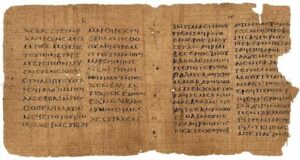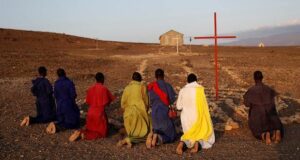An entirely new area of modern tourism is opening up to the faithful in Israel but it’s been a few years in the making. An area of abandoned churches and monasteries along the Jordan River is finally regaining its place in archaeological and religious arenas after years of neglect.
Israeli President Reuven Rivlin took a tour with the heads of Israel’s churches last week as part of a project to develop the area along the Jordan River which is rich in Christian tradition.
The “Land of the Monasteries” is where John the Baptist baptized Jesus and his followers and has rich Old Testament history as well.
The area’s importance is both religious and historical. Over the centuries, monasteries and guest houses were built along the western banks of the Jordan River for the faithful who came to the site to be baptized.
During the Ottoman reign over the land, a time when the ancient land of Israel was virtually ignored by the ruling Muslims, the monasteries were gradually abandoned until the British Mandate in the 20th Century when tourism resumed around Jericho and the baptism site, and new monasteries were built.
An earthquake damaged many buildings in 1956 but the area became almost completely deserted in 1967. Ahead of invading Arab nations who were destroying virtually everything in their path, the churches were abandoned by their inhabitants as Jews and Christians alike fled the onslaught.
At the time, the border stretched to the west perimeter of the site, and mines were placed between the site and the river to deter future Arab armies.
Over the last few years, Rivlin has promoted the initiative to remove the mines and restore the land in order to attract more visitors to the area. The effort is one of modern Israel’s biggest efforts to welcome more tourists since the 1960s.
“The ‘Land of the Monasteries’ is a place of prayer and holiness. A place of pilgrims from afar who come to be closer to God,” said Rivlin. “But it is also a place that has been injured and broken by war in the past. We are now investing large amounts to restore the site and to return the monasteries to their churches so that Christian pilgrims and other people of faith from around the world can come and visit once again.”
One of the most talked about sites is that of St. George Monastery – the amazing cliff-hanging community which is one of the world’s oldest and definitely one of the most inspiring churches in the Holy Land. The site is a considered must-see for both Christian tourists and average Israeli’s who make the trek to marvel at the architecture much like Americans marvel at the cliff dwellings in the Southwest.
St. George’s Monastery was originally begun in the fourth century by a few devout followers of Christ who were looking to immerse themselves in the lifestyles and desert stories of John the Baptist and Jesus. The inhabitants would come to be known as monks, and included perhaps most notably the hermit John of Thebes. They eventually settled on the spot around a cave where it is believed the prophet Elijah was fed by ravens.
 The monastery was destroyed by the Persians and then rebuilt by the Crusaders before falling derelict. It wasn’t until 1878 when a Greek monk, Kalinikos, came to live here that the monastery started to look like its former glorious and cliff-hugging self. Kalinikos finished his renovations in 1901.
The monastery was destroyed by the Persians and then rebuilt by the Crusaders before falling derelict. It wasn’t until 1878 when a Greek monk, Kalinikos, came to live here that the monastery started to look like its former glorious and cliff-hugging self. Kalinikos finished his renovations in 1901.
Today there are still a few Greek Orthodox monks who inhabit the monastery, and who are typically welcoming of visitors. Consequently, a Greek flag still flutters in the breeze on the monastery grounds.
Treasures like St. George are what make the area so special and the Israeli government recognizes that.
“This is part of Israel’s deep commitment to religious freedom. Unfortunately, for centuries those who ruled the Holy Land did not allow peoples of all faiths to access their holy places. Under Israeli sovereignty, people once again enjoy freedom of religion and worship,” he continued. “The fact that we are all investing in this project is not just an expression of our belief in God, but also an expression of our belief in humanity and in each other.”
“Developing this site will be an important step in building bridges between peoples and religions, and will allow the vision of co-existence to become a reality. Cooperation between Israelis, Jordanians and Palestinians, and between Christians, Muslims and Jews,” he added.
“In this beautiful place is a sign of the close friendship between the Jewish and Christian communities in the Holy Land, and around the world.”
“I am here today, to make clear that the State of Israel – as a Jewish and democratic state, democratic and Jewish – holds dear its responsibility to protect the freedom and safety of all faiths in Israel,” he continued. “We are here to make clear, there is no religious war in the holy land, these are attacks by fundamentalists, against a whole society, these are attacks by people who seek war and destruction, against people who seek to live in peace.”
Israel spends hundreds of millions of dollars each year to preserve and protect the holy sites of a religious minority – Christians. It is the only country in the Middle East to do so.
 Metro Voice News Celebrating Faith, Family & Community
Metro Voice News Celebrating Faith, Family & Community 








